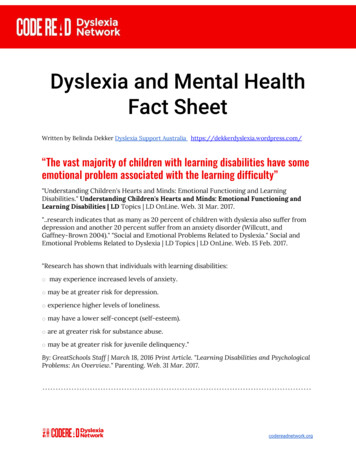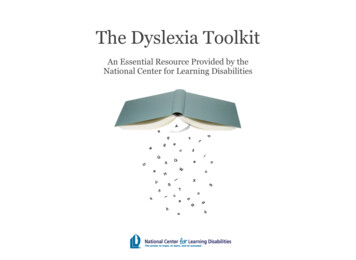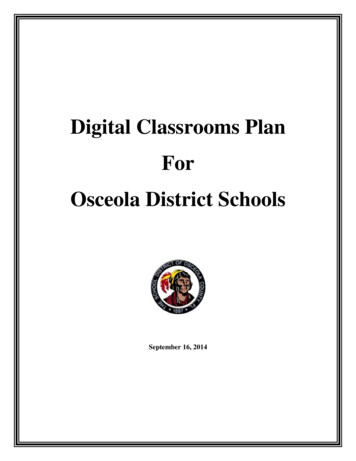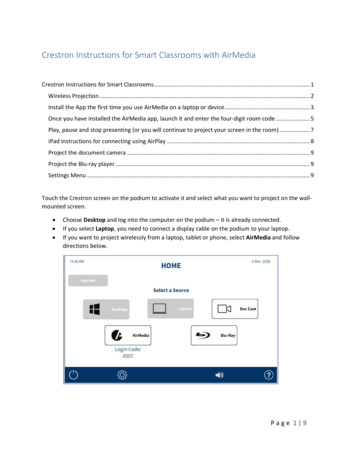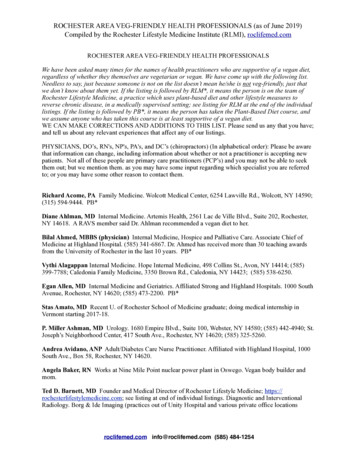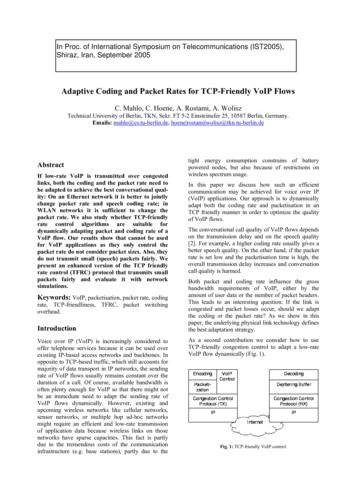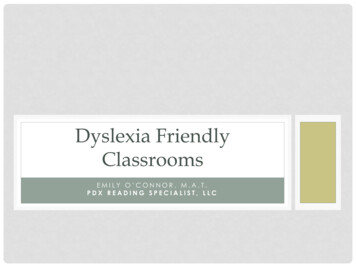
Transcription
Dyslexia FriendlyClassroomsEMILY O’CONNOR, M.A.T.PDX READING SPECIALIST, LLC
Three Key Concepts Safety Emotional safety for the dyslexic student(s) in your class Structure Specific classroom structures to foster learning Support The role of advocates: parents and teachers
Emotional SafetyDyslexics tend to be big picture, feelings-first individuals. Big feelings are hard for kids to experience and understand Things that do not feel good or accessible are avoided for selfpreservation purposes, sometimes unconsciously Uncanny ability to intuit interpersonal dynamics & feelings but children can easily misunderstand and misinterpret Typically painfully aware of their weak areas Deep feelings of shame, inadequacy, failureMost dyslexics will shut down when they do not feel safe.
Emotional Safety: What You Can Do If you support our big picture, we will feel safer! Schedule for the day is posted with visual aides Morning Meeting: due dates, field trips, goals for day Timeline for big assignments/projects provided in many formats Communication is vital Answer/address the “why” questions without frustration Pausing to explain your thinking/choices is helpful Address misunderstood feelings/situations: trust is everything Be pro-active in supporting feelings Allow as much choice as possible (“xxxx or xxx, which works?”) Respect and allow breaks (set specific guidelines) Cultivate a relationship & check-in often
Structure: Ideas for the Classroom Never assume something is accessible If you have not analyzed a current assessment or done oneyourself .we have a big problem, period. Accommodations are vital All dyslexic children benefit from accommodations, butaccommodations are most effective when individualized. Backwards planning from the goal with graphic organizers/flowcharts can be helpful when individualizing accommodations. Craft assignments that celebrate choice Give structured choices (such as a book report that could betyped, made into a poster, or crafted into an iMovie). Encourage students to approach you one-on-one if they havetheir own unique idea for an assignment.
Ear Reading in the Classroom:Why This Accommodation MattersInformation is like water to me, and the learningprocess offers just as many ways to consumeinformation as there are ways to consume water.The knowledge in a conventional book is like ice tome. It has been put into a solid state to be preserved,allowing it to be consumed by a standard reader atany time. Most people can pick up a book and, liketransforming ice into liquid water, quickly transform itinto the information they need to learn. I cannot dothis with my eyes, but I can do it with my ears.--Ben Foss, The Dyslexia Empowerment Plan
Accommodations in the Classroom:Some Guiding PrincipalsAccommodations require education & teamwork. Educate yourself as to what is out there, and create a planwith your specific child/student in mind. Technology cannot be just handed to a child: you must teachhim/her how to use the technology. Be flexible and realistic. Use the technology as much as youcan yourself before teaching a child how to use it. Ifsomething seems really awesome but is not functional inpractice, reevaluate and change course. Learn fromexperience, and practice non-attachment. Encourage a practice of self-advocacy when appropriate.
Inclusive Classrooms:1. Make content accessible to the fulldiversity of learners.1. Allow students to demonstratecontent mastery in moreindividualized/accessible ways.1. Keep kids safe.
Support: Parents as Advocates at School Process your own guilt and shame. And then educateyourself as soon as possible, and as much as possible. Do not make assumptions and listen to your gut. Practice compassion: towards yourself, towards yourfamily, and towards the hardworking teachers who youhave a chance to impact positively. Be pro-active in finding solutions to road blocks, and: Have access to data/assessment for proof Create a plan, communicate the plan, revise the plan If needed, consult a professional: we will work with and for you!
Support: Parents as Advocates at Home Your child needs to engage with rich text at hisintellect level as much as possible. Make this timecomfortable, enjoyable, and shame-free. Get your child the services that will teach her howto eye read and spell. Find an activity that your child loves and feelssuccessful doing, and encourage his participation.
I wish I could have seen and understood theseelements of the brain when I was young andstruggling to fit in, because the brain imagesclearly show what I’ve found out to be true: thatno matter how hard you try, you can’t changewho you are. Seeing the picture of my dyslexicbrain was incredibly powerful for me. The key tomy happiness occurred when I stopped trying tochange my brain, and started changing thecontext around me.--Ben Foss, The Dyslexia Empowerment Plan
Support: Teachers as Advocates If you know what dyslexia is and suspect a child may bedyslexic, tell the parents and use the word. Create a classroom culture that celebrates difference.The mantra is, “Fair is not equal: fair is everyone getswhat he or she needs to be successful. I am the teacherand it is my job to make sure everyone is successful.” Recognize that students who need support often needyou to be proactive in offering that support. Consider pursuing training that will equip you with theknowledge you need to make difference for dyslexics.
Call to Action:Be Agents of ChangeEmily O’Connor, M.A.T.PDX Reading Specialist, LLCoconnor@pdxreadingspecialist.com503.747.3491
The knowledge in a conventional book is like ice to me. It has been put into a solid state to be preserved, allowing it to be consumed by a standard reader at any time. Most people can pick up a book and, like transforming ice into liquid water, quickly transform it into the information they need to learn. I cannot do this with my eyes, but I can do it with my ears.--Ben Foss, The Dyslexia .
